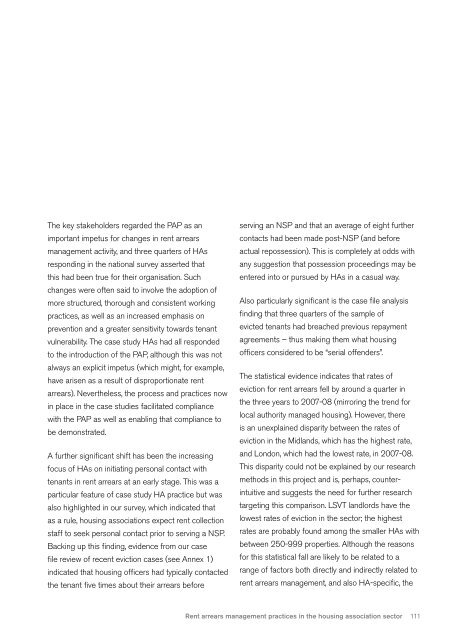Rent arrears management practices in the housing association sector
Rent arrears management practices in the housing association sector
Rent arrears management practices in the housing association sector
You also want an ePaper? Increase the reach of your titles
YUMPU automatically turns print PDFs into web optimized ePapers that Google loves.
The key stakeholders regarded <strong>the</strong> PAP as an<br />
important impetus for changes <strong>in</strong> rent <strong>arrears</strong><br />
<strong>management</strong> activity, and three quarters of HAs<br />
respond<strong>in</strong>g <strong>in</strong> <strong>the</strong> national survey asserted that<br />
this had been true for <strong>the</strong>ir organisation . Such<br />
changes were often said to <strong>in</strong>volve <strong>the</strong> adoption of<br />
more structured, thorough and consistent work<strong>in</strong>g<br />
<strong>practices</strong>, as well as an <strong>in</strong>creased emphasis on<br />
prevention and a greater sensitivity towards tenant<br />
vulnerability . The case study HAs had all responded<br />
to <strong>the</strong> <strong>in</strong>troduction of <strong>the</strong> PAP, although this was not<br />
always an explicit impetus (which might, for example,<br />
have arisen as a result of disproportionate rent<br />
<strong>arrears</strong>) . Never<strong>the</strong>less, <strong>the</strong> process and <strong>practices</strong> now<br />
<strong>in</strong> place <strong>in</strong> <strong>the</strong> case studies facilitated compliance<br />
with <strong>the</strong> PAP as well as enabl<strong>in</strong>g that compliance to<br />
be demonstrated .<br />
A fur<strong>the</strong>r significant shift has been <strong>the</strong> <strong>in</strong>creas<strong>in</strong>g<br />
focus of HAs on <strong>in</strong>itiat<strong>in</strong>g personal contact with<br />
tenants <strong>in</strong> rent <strong>arrears</strong> at an early stage . This was a<br />
particular feature of case study HA practice but was<br />
also highlighted <strong>in</strong> our survey, which <strong>in</strong>dicated that<br />
as a rule, hous<strong>in</strong>g <strong>association</strong>s expect rent collection<br />
staff to seek personal contact prior to serv<strong>in</strong>g a NSP .<br />
Back<strong>in</strong>g up this f<strong>in</strong>d<strong>in</strong>g, evidence from our case<br />
file review of recent eviction cases (see Annex 1)<br />
<strong>in</strong>dicated that hous<strong>in</strong>g officers had typically contacted<br />
<strong>the</strong> tenant five times about <strong>the</strong>ir <strong>arrears</strong> before<br />
serv<strong>in</strong>g an NSP and that an average of eight fur<strong>the</strong>r<br />
contacts had been made post-NSP (and before<br />
actual repossession) . This is completely at odds with<br />
any suggestion that possession proceed<strong>in</strong>gs may be<br />
entered <strong>in</strong>to or pursued by HAs <strong>in</strong> a casual way .<br />
Also particularly significant is <strong>the</strong> case file analysis<br />
f<strong>in</strong>d<strong>in</strong>g that three quarters of <strong>the</strong> sample of<br />
evicted tenants had breached previous repayment<br />
agreements – thus mak<strong>in</strong>g <strong>the</strong>m what hous<strong>in</strong>g<br />
officers considered to be “serial offenders” .<br />
The statistical evidence <strong>in</strong>dicates that rates of<br />
eviction for rent <strong>arrears</strong> fell by around a quarter <strong>in</strong><br />
<strong>the</strong> three years to 2007-08 (mirror<strong>in</strong>g <strong>the</strong> trend for<br />
local authority managed hous<strong>in</strong>g) . However, <strong>the</strong>re<br />
is an unexpla<strong>in</strong>ed disparity between <strong>the</strong> rates of<br />
eviction <strong>in</strong> <strong>the</strong> Midlands, which has <strong>the</strong> highest rate,<br />
and London, which had <strong>the</strong> lowest rate, <strong>in</strong> 2007-08 .<br />
This disparity could not be expla<strong>in</strong>ed by our research<br />
methods <strong>in</strong> this project and is, perhaps, counter<strong>in</strong>tuitive<br />
and suggests <strong>the</strong> need for fur<strong>the</strong>r research<br />
target<strong>in</strong>g this comparison . LSVT landlords have <strong>the</strong><br />
lowest rates of eviction <strong>in</strong> <strong>the</strong> <strong>sector</strong>; <strong>the</strong> highest<br />
rates are probably found among <strong>the</strong> smaller HAs with<br />
between 250-999 properties . Although <strong>the</strong> reasons<br />
for this statistical fall are likely to be related to a<br />
range of factors both directly and <strong>in</strong>directly related to<br />
rent <strong>arrears</strong> <strong>management</strong>, and also HA-specific, <strong>the</strong><br />
<strong>Rent</strong> <strong>arrears</strong> <strong>management</strong> <strong>practices</strong> <strong>in</strong> <strong>the</strong> hous<strong>in</strong>g <strong>association</strong> <strong>sector</strong> 111




